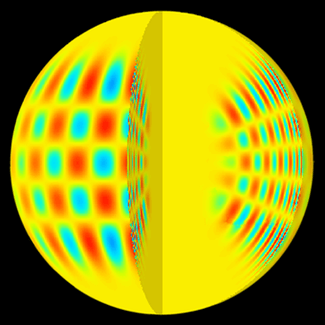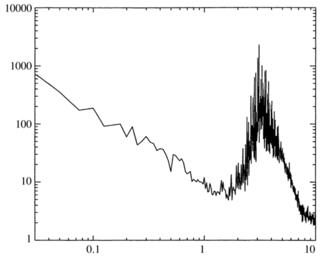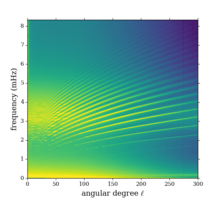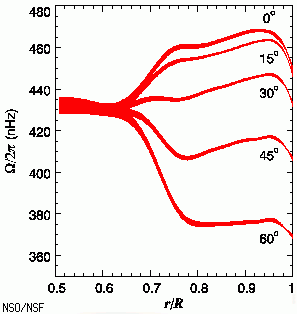Helioseismology

Helioseismology is the study of the propagation of wave oscillations, particularly acoustic pressure waves, in the Sun. Unlike seismic waves on Earth, solar waves have practically no shear component (s-waves). Solar pressure waves are believed to be generated by the turbulence in the convection zone near the surface of the sun.[1] Certain frequencies are amplified by constructive interference. In other words, the turbulence "rings" the sun like a bell. The acoustic waves are transmitted to the outer photosphere of the sun, which is where the light generated through absorption of radiant energy from nuclear fusion at the centre of the sun, leaves the surface. These oscillations are detectable on almost any time series of solar images, but are best observed by measuring the Doppler shift of photospheric absorption lines. Changes in the propagation of oscillation waves through the Sun reveal inner structures and allow astrophysicists to develop extremely detailed profiles of the interior conditions of the Sun.
Helioseismology was able to rule out the possibility that the solar neutrino problem was due to incorrect models of the interior of the Sun.[2] Features revealed by helioseismology include that the outer convective zone and the inner radiative zone rotate at different speeds, which is thought to generate the main magnetic field of the Sun by a dynamo effect,[3][4] and that the convective zone has "jet streams" of plasma (more precisely, torsional oscillations) thousands of kilometers below the surface.[5] These jet streams form broad fronts at the equator, breaking into smaller cyclonic storms at high latitudes. Torsional oscillations are the time variation in solar differential rotation. They are alternating bands of faster and slower rotation. So far there is no generally accepted theoretical explanation for them, even though a close relation to the solar cycle is evident, as they have a period of eleven years, as was known since they were first observed in 1980.[6]
Helioseismology can also be used to image the far side of the Sun from the Earth,[7] including sunspots. In simple terms, sunspots absorb helioseismic waves. This sunspot absorption causes a seismic deficit that can be imaged at the antipode of the sunspot.[8] To facilitate spaceweather forecasting, seismic images of the central portion of the solar far side have been produced nearly continuously since late 2000 by analysing data from the SOHO spacecraft, and since 2001 the entire far side has been imaged with this data.
Despite the name, helioseismology is the study of solar waves and not solar seismic activity. The name is derived from the similar practice of studying terrestrial seismic waves to determine the composition of the Earth's interior. The science can be compared to asteroseismology, which studies the propagation of sound waves in stars.
Types of solar oscillations

Individual oscillations in the Sun are damped so that they die out within a few periods. However, interference between these localised waves produces global standing waves, also known as normal modes. Analysis of these overlapping modes constitutes the discipline of global helioseismology.
Solar oscillation modes are essentially divided up into three categories, based on the restoring force that drives them: acoustic, gravity, and surface-gravity wave modes.
- p-mode or acoustic waves have pressure as their restoring force, hence the name "p-mode". Their dynamics are determined by the variation of the speed of sound inside the sun. P-mode oscillations have frequencies > 1 mHz and are very strong in the 2-4 mHz range, where they are often referred to as "5-minute oscillations". (Note: 5 minutes per cycle is 1/300 cycles per second= 3.33 mHz.) P-modes at the solar surface have amplitudes of hundreds of kilometers and are readily detectable with Doppler imaging or sensitive spectral line intensity imaging. Thousands of p-modes of high and intermediate degree l (see below for the wavenumber degree l) have been detected by the Michelson Doppler Imager (MDI) instrument aboard the SOHO spacecraft, with those of degree l below 200 clearly separated and higher degree modes ridged together.[9] About 10 p-modes below 1.5mHz have been detected by the GOLF instrument aboard the SOHO spacecraft.[10]
- g-mode or gravity waves are density waves which have gravity (negative buoyancy of displaced material) as their restoring force, hence the name "g-mode". The g-mode oscillations are low frequency waves (0-0.4 mHz). They are confined to the interior of the sun below the convection zone (which extends from 0.7-1.0 solar radius), and are practically inobservable at the surface. The restoring force is caused by adiabatic expansion: in the deep interior of the Sun, the temperature gradient is weak, and a small packet of gas that moves (for example) upward will be cooler and denser than the surrounding gas, and will therefore be pulled back to its original position; this restoring force drives g-modes. In the solar convection zone, the temperature gradient is slightly greater than the adiabatic lapse rate, so that there is an anti-restoring force (that drives convection) and g-modes cannot propagate. The g modes are evanescent through the entire convection zone, and are thought to have residual amplitudes of only millimeters at the photosphere, though more prominent as temperature perturbations.[11] Since the '80s, there have been several claims of g-mode detection, none of which have been confirmed. In 2007, another g-mode detection was claimed using the GOLF data.[12] At the GONG2008 / SOHO XXI conference held in Boulder, the Phoebus group reported that it could not confirm these findings, putting an upper limit on the g-mode amplitude to 3 mm/s, right at the detection limit of the GOLF instrument. Finally, the Phoebus group has just published a review over the current state of knowledge on the solar g modes.[13]
- f-mode or surface gravity waves are also gravity waves, but occur at or near the photosphere, where the temperature gradient again drops below the adiabatic lapse rate. Some f-modes of moderate and high degree, between l= 117 and l= 300, (see below for the wavenumber degree l) have been observed by MDI.[14]
Analysis of oscillation data

The data from time-series of solar spectra show all the oscillations overlapping. Thousands of modes have been detected (with the true number perhaps being in the millions). The mathematical technique of Fourier analysis is used to recover information about individual modes from this mass of data. The idea is that any periodic function can be written as a sum of multiples of the simplest periodic functions, which are sines and cosines (of different frequencies). To find out how much (the amplitude) of each simple function goes into , one applies the Fourier transform: at each point the value of this transform is obtained by computing a particular integral involving a modified version of .
The simplest modes to analyse are the radial ones; however most solar modes are non-radial. A nonradial mode is characterized by three wavenumbers: the spherical-harmonic degree and azimuthal order which determine the behaviour of the mode over the surface of the star and the radial order which reflects the properties in the radial direction (see the diagram on the top right for an example). Note that if the Sun were spherically symmetric, the azimuthal order would exhibit degeneracy; however the rotation of the Sun (along with other perturbations), which leads to an equatorial bulge, lifts this degeneracy. By convention, corresponds to the number of nodes of the radial eigenfunction, indicates the total number of nodal lines on spheres, and tells how many of these nodal lines cross the equator.
In general the frequencies of stellar oscillations depend on all three wave numbers. It is convenient, however, to separate the frequency into the multiplet frequency , obtained as a suitable average over azimuthal order and corresponding to the spherically symmetric structure of the star, and the frequency splitting .
Analyses of oscillation data must attempt to separate these different frequency components. In the case of the Sun the oscillations can be observed directly as functions of position on the solar disk as well as time. Thus here it is possible to analyze their spatial properties. This is done by means of a generalized 2-dimensional Fourier transform in position on the solar surface, to isolate particular values of and . This is followed by a Fourier transform in time which isolates the frequencies of the modes of that type. In fact, the average over the stellar surface implicit in observations of stellar oscillations can be thought of as one example of such a spatial Fourier transform.
Note that the oscillation data, rather than a continuous function, amount to values constrained by experimental error evaluated at a grid of positions and times. When computing transforms, values of this "function" outside this grid have to be interpolated and the integrals approximated by finite sums, a process inevitably introducing further errors. Details of the numerical methods used are included with the transformed data for purposes of comparison and constraining errors.
This discussion is adapted from the Jørgen Christensen-Dalsgaard lecture notes on stellar oscillations.[16]
Inversion

Information about helioseismic waves (such as mode frequencies and frequency-splitting) collected by transforming the oscillation data can be used to infer numerical details of internal features of the Sun such as the internal sound speed and the internal differential rotation. Equations and analytic relations such as integrals can be manipulated to relate the desired internal properties to the transformed data. The numerical methods used are adapted to the particular internal features examined so as to extract the maximum amount of information, with the least error, from the oscillations about the internal features. This process is termed helioseismic inversion.
As an example in slightly more detail, the oscillation frequency splitting can be related, via an integral, to the angular velocity within the sun.[16]
Internal structure
Helioseismic observations reveal the inner uniformly rotating zone and the differentially rotating envelope of the Sun, roughly corresponding to the radiation and convection zones, respectively.[3] See the diagram on the right. The transition layer is called the tachocline.
Helioseismic dating
The age of the sun can be inferred with helioseismic studies.[17] This is because the propagation of acoustic waves deep within the sun depends on the composition of the sun, in particular the relative abundance of helium and hydrogen in the core. Since the sun has been fusing hydrogen into helium throughout its lifetime, the present day abundance of helium in the core can be used to infer the age of the sun, using numerical models of stellar evolution applied to the Sun (standard solar model). This method provides verification of the age of the solar system gathered from the radiometric dating of meteorites.[18]
Local helioseismology
The goal of local helioseismology, a term first used in 1993,[19] is to interpret the full wave field observed at the surface, not just the mode (more precisely, eigenmode) frequencies. Another way to look at it, is that global helioseismology studies standing waves of the entire Sun and local helioseismology studies propagating waves in parts of the Sun. A variety of solar phenomena are being studied, including sunspots, plage, supergranulation, giant cell convection, magnetically active region evolution, meridional circulation, and solar rotation.[20] Local helioseismology provides a three-dimensional view of the solar interior, which is important to understand large-scale flows, magnetic structures, and their interactions in the solar interior.
There are many techniques used in this new and expanding field, which include:
- Fourier–Hankel spectral method, first introduced by Braun and Duvall,[21] was originally used to search for wave absorption by sunspots.
- Ring-diagram analysis, first introduced by F. Hill,[22] is used to infer the speed and direction of horizontal flows below the solar surface by observing the Doppler shifts of ambient acoustic waves from power spectra of solar oscillations computed over patches of the solar surface (typically 15° × 15°). Thus ring analysis is a generalization of global helioseismology applied to local areas on the Sun (as opposed to half of the Sun). For example, sound speed and adiabatic index can be compared within magnetically active and inactive (quiet Sun) regions.[23]
- Time-distance helioseismology, introduced by Duvall et al.,[24] aims to measure and interpret the travel times of solar waves between any two locations on the solar surface. A travel time anomaly contains the seismic signature of buried inhomogeneities within the proximity of the ray path that connects two surface locations. An inverse problem must then be solved to infer the local structure and dynamics of the solar interior.[25]
- Helioseismic holography, introduced in detail by Lindsey and Braun for the purpose of far-side (magnetic) imaging,[7] a special case of phase-sensitive holography. The idea is to use the wavefield on the visible disk to learn about active regions on the far side of the Sun. The basic idea in helioseismic holography is that the wavefield, e.g., the line-of-sight Doppler velocity observed at the solar surface, can be used to make an estimate of the wavefield at any location in the solar interior at any instant in time. In this sense, holography is much like seismic migration, a technique in geophysics that has been in use since the 1940s. As another example, this technique has been used to give a seismic image of a solar flare.[26] Acoustic holography, applied to MDI data, is ideal for the detection of sources and sinks of acoustic waves on the Sun. Braun and Fan [27] discovered a region of lower acoustic emission in the 3 – 4 mHz frequency band which extends far beyond the sunspots (the ‘acoustic moat’). Acoustic moats extend beyond magnetic regions into the quiet Sun. In addition, Braun and Lindsey [28] discovered high-frequency emission (‘acoustic glories’) surrounding active regions.
- Direct modelling, after Woodard.[29] Here the idea is to estimate subsurface flows from direct inversion of the frequency-wavenumber correlations seen in the wavefield in the Fourier domain. Woodard[29] gave a practical demonstration of the ability of the technique to recover near-surface flows from the f-mode part of the spectrum.
This section is adapted from Laurent Gizon and Aaron C. Birch, "Local Helioseismology", Living Rev. Solar Phys. 2, (2005), 6. online article (cited on November 22, 2009).
Jet stream movement may affect solar cycle
An internal jet stream moving behind schedule may explain the delayed start to the solar cycle in 2009.[30]
See also
- 160-minute solar cycle
- Asteroseismology
- Differential rotation
- Diskoseismology
- Magnetogravity wave
- Moreton wave
- Solar neutrino problem
- Solar tower (astronomy)
- Stellar rotation
References
- ↑ Goldreich, P.; Keeley, D.A. (February 1977). "Solar seismology. II - The stochastic excitation of the solar p-modes by turbulent convection". Astrophysical Journal. 212: 243–251. Bibcode:1977ApJ...212..243G. doi:10.1086/155043.
- ↑ Bahcall, J.N.; Pinsonneault, M.H.; Basu, S.; Christensen-Dalsgaard, J. (January 1997). "Are Standard Solar Models Reliable?". Physical Review Letters. 78 (2): 171–174. arXiv:astro-ph/9610250
 . Bibcode:1997PhRvL..78..171B. doi:10.1103/PhysRevLett.78.171.
. Bibcode:1997PhRvL..78..171B. doi:10.1103/PhysRevLett.78.171. - 1 2 Thompson, M.J.; Christensen-Dalsgaard, J.; Miesch, M.S.; Toomre, J. (2003). "The Internal Rotation of the Sun". Annual Review of Astronomy & Astrophysics. 41 (1): 599–643. Bibcode:2003ARA&A..41..599T. doi:10.1146/annurev.astro.41.011802.094848.
- ↑ Ossendrijver, M. (2003). "The solar dynamo". The Astronomy and Astrophysics Review. 11 (4): 287–367. Bibcode:2003A&ARv..11..287O. doi:10.1007/s00159-003-0019-3.
- ↑ Vorontsov, S.V.; Christensen-Dalsgaard, J.; Schou, J.; Strakhov, V.N.; Thompson, M.J. (April 2002). "Helioseismic Measurement of Solar Torsional Oscillations". Science. 296 (5565): 101–103. Bibcode:2002Sci...296..101V. doi:10.1126/science.1069190. PMID 11935019.
- ↑ Howard, R.; Labonte, B.J. (July 1980). "The sun is observed to be a torsional oscillator with a period of 11 years". Astrophysical Journal. 239: L33–L36. Bibcode:1980ApJ...239L..33H. doi:10.1086/183286.
- 1 2 Braun, D.C.; Lindsey, C. (October 2001). "Seismic Imaging of the Far Hemisphere of the Sun". The Astrophysical Journal. 560 (2): L189–L192. Bibcode:2001ApJ...560L.189B. doi:10.1086/324323.
- ↑ Lindsey, C.; Braun, D.C. (March 1990). "Helioseismic imaging of sunspots at their antipodes". Solar Physics. 126 (1): 101–115. Bibcode:1990SoPh..126..101L. doi:10.1007/BF00158301.
- ↑ Rabello-Soares, M.C.; Korzennik, S.G.; Schou, J. (January 2001). "The determination of MDI high-degree mode frequencies". In: Proceedings of the SOHO 10/GONG 2000 Workshop: Helio- and asteroseismology at the dawn of the millennium. ESA Special Publication. 464: 129–136. Bibcode:2001ESASP.464..129R.
- ↑ Garcia, R.A.; Regulo, C.; Turck-Chieze, S.; Bertello, L.; Kosovichev, A.G.; Brun, A.S.; Couvidat, S.; Henney, C.J.; Lazrek, M.; Ulrich, R.K.; Varadi, F. (May 2001). "Low-Degree Low-Order Solar p Modes As Seen By GOLF On board SOHO". Solar Physics. 20: 361–379. Bibcode:2001SoPh..200..361G. doi:10.1023/A:1010344721148.
- ↑ http://www.springerlink.com/content/xt03jqk462770337/
- ↑ Garcia, R.A.; Turck-Chieze, S.; Jimenez-Reyes, S.J.; Ballot, J.; Palle, P.L.; Eff-Darwich, A.; Mathur, S.; Provost, J. (June 2007). "Tracking Solar Gravity Modes: The Dynamics of the Solar Core". Science. 316 (5831): 1591–. Bibcode:2007Sci...316.1591G. doi:10.1126/science.1140598. PMID 17478682.
- ↑ Appourchaux, T.; Belkacem, K.; Broomhall, A. M.; Chaplin, W. J.; Gough, D. O.; Houdek, G.; Provost, J.; Baudin, F.; Boumier, P.; Elsworth, Y.; García, R. A.; Andersen, B.; Finsterle, W.; Fröhlich, C.; Gabriel, A.; Grec, G.; Jiménez, A.; Kosovichev, A.; Sekii, T.; Toutain, T.; Turck-Chièze, S. (October 2009). "The quest for the solar g modes". 0910: 848. arXiv:0910.0848
 [astro-ph.SR]. Bibcode:2009arXiv0910.0848A.
[astro-ph.SR]. Bibcode:2009arXiv0910.0848A. - ↑ Corbard, T.; Thompson, M.J. (February 2002). "The subsurface radial gradient of solar angular velocity from MDI f-mode observations". Solar Physics. 205 (2): 211–229. arXiv:astro-ph/0110361
 . Bibcode:2002SoPh..205..211C. doi:10.1023/A:1014224523374.
. Bibcode:2002SoPh..205..211C. doi:10.1023/A:1014224523374. - ↑ Rhodes, Jr. E. J.; Kosovichev, A. G.; Schou, J.; et al. (1997), "Measurements of Frequencies of Solar Oscillations from the MDI Medium-l Program", Solar Physics, 175: 287, Bibcode:1997SoPh..175..287R
- 1 2 Christensen-Dalsgaard, J., 2003, Lecture Notes on Stellar Oscillations. Fifth Edition, lecture notes, University of Aarhus. Retrieved November 2009.
- ↑ Bonanno, A.; Schlattl, H.; Paternò, L. (2002). "The age of the Sun and the relativistic corrections in the EOS". Astronomy and Astrophysics. 390 (3): 1115. arXiv:astro-ph/0204331
 . Bibcode:2002A&A...390.1115B. doi:10.1051/0004-6361:20020749.
. Bibcode:2002A&A...390.1115B. doi:10.1051/0004-6361:20020749. - ↑ Guenther, D.B. (April 1989). "Age of the sun". Astrophysical Journal. 339: 1156–1159. Bibcode:1989ApJ...339.1156G. doi:10.1086/167370.
- ↑ Lindsey, C.; Braun, D.C.; Jefferies, S.M. (January 1993). T.M. Brown, ed. ""Local Helioseismology of Subsurface Structure" in "GONG 1992. Seismic Investigation of the Sun and Stars"". GONG 1992. Seismic Investigation of the Sun and Stars. Proceedings of a Conference held in Boulder. Astronomical Society of the Pacific Conference Series. 42: 81–84. Bibcode:1993ASPC...42...81L. ISBN 0-937707-61-9.
- ↑ Duvall, Jr.; T.L. (1998). S. Korzennik, ed. ""Recent Results and Theoretical Advances in Local Helioseismology" in "Structure and Dynamics of the Interior of the Sun and Sun-like Stars"". Structure and Dynamics of the Interior of the Sun and Sun-like Stars SOHO 6/GONG 98 Workshop Abstract. ESA Special Publication. 418: 581–585. Bibcode:1998ESASP.418..581D.
- ↑ Braun, D.C.; Duvall, Jr., T.L.; Labonte, B.J. (August 1987). "Acoustic absorption by sunspots". Astrophysical Journal. 319: L27–L31. Bibcode:1987ApJ...319L..27B. doi:10.1086/184949.
- ↑ Hill, F. (October 1988). "Rings and trumpets - Three-dimensional power spectra of solar oscillations". Astrophysical Journal. 333: 996–1013. Bibcode:1988ApJ...333..996H. doi:10.1086/166807.
- ↑ Basu, S.; Antia, H.M.; Bogart, R.S. (August 2004). "Ring-Diagram Analysis of the Structure of Solar Active Regions". The Astrophysical Journal. 610 (2): 1157–1168. Bibcode:2004ApJ...610.1157B. doi:10.1086/421843.
- ↑ Duvall, Jr., T.L.; Jefferies, S.M.; Harvey, J.W.; Pomerantz, M.A. (April 1993). "Time-distance helioseismology". Nature. 362 (6419): 430–432. Bibcode:1993Natur.362..430D. doi:10.1038/362430a0.
- ↑ Jensen, J.M., 2003, Time-distance: what does it tell us?, in Local and Global Helioseismology: The Present and Future, (Ed.) Sawaya-Lacoste, H., Proceedings of SOHO 12/GONG+ 2002, 27 October - 1 November 2002, Big Bear Lake, California, U.S.A., vol. SP-517 of ESA Conference Proceedings, pp. 61–70, ESA Publications Division, Noordwijk
- ↑ Donea, A.-C.; Braun, D.C.; Lindsey, C. (March 1999). "Seismic Images of a Solar Flare". The Astrophysical Journal. 513 (2): L143–L146. Bibcode:1999ApJ...513L.143D. doi:10.1086/311915.
- ↑ Braun, D.C.; Fan, Y. (November 1998). "Helioseismic Measurements of the Subsurface Meridional Flow". The Astrophysical Journal. 508 (1): L105–L108. Bibcode:1998ApJ...508L.105B. doi:10.1086/311727.
- ↑ Braun, D.C.; Lindsey, C. (March 1999). "Helioseismic Images of an Active Region Complex". The Astrophysical Journal. 513 (1): L79–L82. Bibcode:1999ApJ...513L..79B. doi:10.1086/311897.
- 1 2 Woodard, M.F. (January 2002). "Solar Subsurface Flow Inferred Directly from Frequency-Wavenumber Correlations in the Seismic Velocity Field". The Astrophysical Journal. 565 (1): 634–639. Bibcode:2002ApJ...565..634W. doi:10.1086/324546.
- ↑ Minard, Anne. "The Case of the Missing Sunspots: Solved?". Universe Today.
External links
| Wikimedia Commons has media related to Helioseismology. |
- Non-technical description of helio- and asteroseismology retrieved November 2009
- Laurent Gizon and Aaron C. Birch, "Local Helioseismology", Living Rev. Solar Phys. 2 (2005) 6, url:http://www.livingreviews.org/lrsp-2005-6 doi:10.12942/lrsp-2005-6
- Scientists Issue Unprecedented Forecast of Next Sunspot Cycle National Science Foundation press release, March 6, 2006
- Mark S. Miesch, "Large-Scale Dynamics of the Convection Zone and Tachocline", Living Rev. Solar Phys. 2 (2005) 1, url:http://www.livingreviews.org/lrsp-2005-6 doi:10.12942/lrsp-2005-1
- European Helio- and Asteroseismology Network (HELAS)
- Farside and Earthside images of the Sun
- Living Reviews in Solar Physics
- Helioseismology and Asteroseismology at MPS
